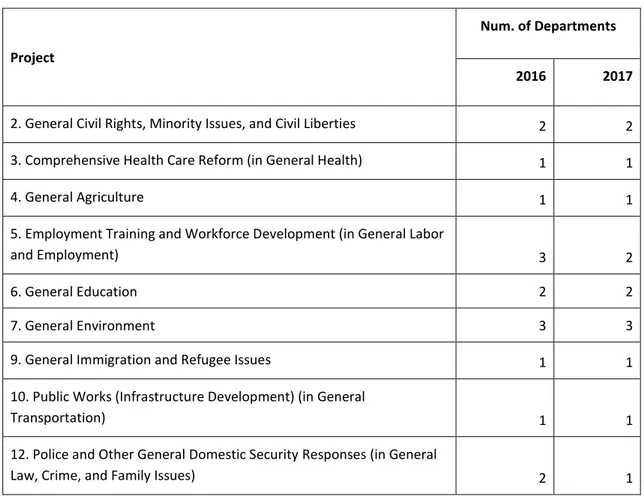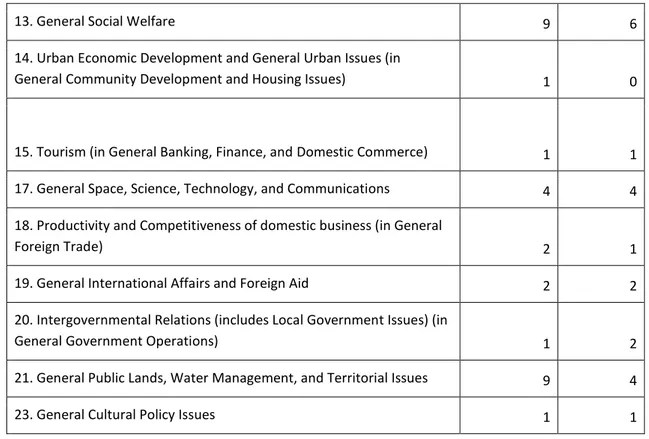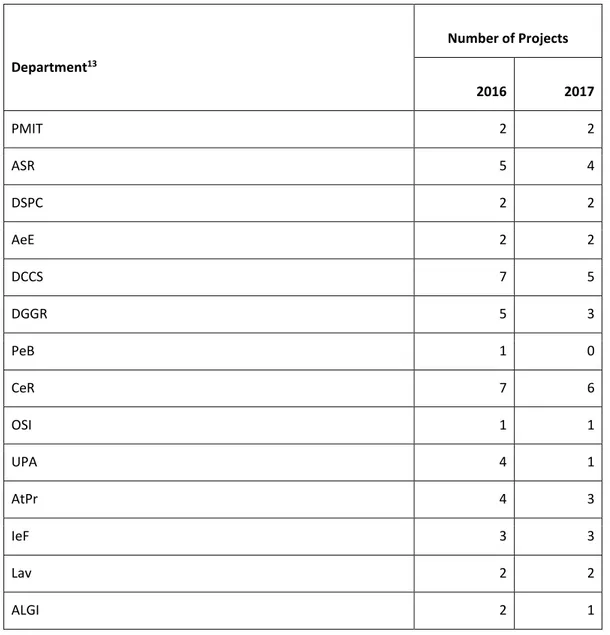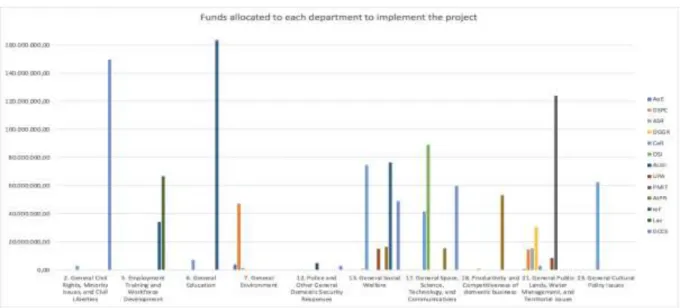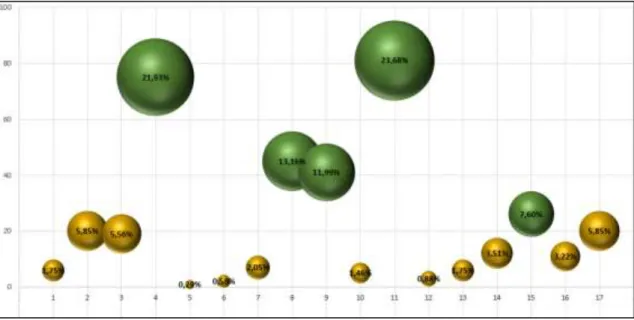11 June 2021
Cavalieri, A., & Cresti, S. (2018). Which silos first? Analysing the Italian case through the study of Tuscany Region’s government. In Proceedings From ICSD 2018.
This is the peer reviewd version of the followng article:
Which silos first? Analysing the Italian case through the study of Tuscany Region’s government
Terms of use: Open Access
(Article begins on next page)
The terms and conditions for the reuse of this version of the manuscript are specified in the publishing policy. Works made available under a Creative Commons license can be used according to the terms and conditions of said license. For all terms of use and more information see the publisher's website.
Availability:
This version is available http://hdl.handle.net/11365/1121092 since 2020-11-25T17:51:06Z Original:
Which silos first?
An assessment of the Italian case of Tuscany region’s government Alice Cavalieri1, Simone Cresti2
Abstract
This paper proposes a public policies analysis of the Tuscany region’s government (Italy) during the current legislature with the aims of (1) selecting the stronger silos, at the regional level, preventing the achievement of the SDGs and (2) proposing a possible solution of multilevel governance in order to comply with policy coherence in elaborating a national strategy for the Sustainable Development. This bottom-up approach (from local to national level) wants to launch the idea that concrete initiatives can start from territories and local administrations, breaking down silos-thinking, thanks to the involvement of different departments in local projects, with the allocation of funds in an inter-sectorial perspective. This is a first attempt to provide a methodological framework for studying the implementation of the SDGs at local level. Through the lens of the Comparative Agenda Project and the Comparative Manifesto Project, we analyse the case of Tuscany region during the current legislation (2015-present) in implanting the SDGs through the involvement of different departments in local projects. Afterwards, we identify the “strong silos” to be broken on the basis of the low level of department differentiation in the allocation of funds. More precisely, we aim to investigate whether a relationship between the local government’s intentions as stated in the manifestos and its actual commitment over spending programs exists. Evidently, the policy agenda is not only about what is being discussed by political actors and their electoral purposes, but also about what they actually do once in office, where a number of institutional factors and political dynamics intervene. In the second part the paper focuses on the relationships between the regional and the national level assessing coherence with the national strategy for the Sustainable Development as described in the Voluntary National Review presented by the Italian Government at the High Level Political Forum 2017.
1 Sant’Anna School of Advanced Studies, PhD candidate. ([email protected]) 2 University of Siena, PhD candidate. ([email protected])
1. A territorial approach to the Agenda 2030
After almost three years since its adoption, the Agenda 2030 is more and more becoming a policy agenda for territories, local governments and municipalities, rather than for states. This is a crucial aspect for the success of the Agenda and the achievement of the Goals (SDGs). Indeed, as confirmed by the Network of Regional Governments for the Sustainable Development (nrg4SD), “the success of the Agenda 2030 will greatly depend on its implementation in cities and territories”3. Local policy makers are actors playing an important role for putting forward
concrete and measurable actions for the sustainable development. Nevertheless the process of localization of SDGs needs to take into consideration firstly the principle of policy coherence among all the levels of governance to ensure cross-scale integration and secondly the need to break the silos approach in formulating public policies.
This paper does not want to provide a quality assessment of the politics at the regional level neither to put forward any ranking, rather wants to open a discussion on the existing aspects of localizations of the SDGs looking at the current legislature, in order to identify a starting point and a methodology for a public policy analysis through the lens of the Agenda 2030. This model for analysis could be replicated with the aim of both mapping the state of the art of the real adoption of the Agenda at the regional level and prioritizing the actions.
The overarching questions of this report are the following: 1. Which kind of policies do we focus on?
2. How to select which specific SDG(s) a policy contributes to?
3. How to identify “silos” to break down, thus which priorities need to be considered? The case study we propose in this paper is the current legislature (2015-present) of the Regional Government of Tuscany, a region in the centre of Italy that in the last months has collaborated with the regional network SDSN Mediterranean and the University of Siena – of which is hosting institution (Groppi et al 2018)4. The partnership aimed at analysing and contextualising regional
policies with the Italian Strategy for the Sustainable Development5 (national level) and with the
Agenda 2030 (global level) in order to assess policy coherence and to highlight most of the efforts towards the Goals that the regional government had already put forward and is still on the process of. During the initial phase of this work we faced the problem of how to operationalize the relationships between policies and Goals and then to evaluate which policies we had to take in to consideration.
In literature this problem hasn’t being fully approached yet firstly because, in line with the “youth” of Agenda 2030, the process of localization of the SDGs is at its initial phases, secondly because from a discipline perspective, political science isn’t – yet in our opinion – a leader discipline for studying and defining sustainable development strategies as instead hard sciences or economy are.
In 2017, Italy presented the National Sustainable Development Strategy (NSDS) at the High Level Political Forum (HLPF) of the United Nations in New York6. The review illustrated how Italy was
– and is still – engaged in contributing to the achievement of the 2030 Sustainable Development
3 nrg4SD “Localizing the SDGs: Regional Governments Paving The Way”, 2018
4This paper builds on a recent scientific collaboration between Tuscany Region, the Department of Business and Law of the University of Siena and SDSN Mediterranean with the title “Analisi delle politiche regionali nella prospettiva della implementazione degli SDGs e dell’Agenda 2030”. Data used for the present analysis comes from that work.
5 more info here:
http://www.minambiente.it/sites/default/files/archivio_immagini/Galletti/Comunicati/snsvs_ottobre20 17.pdf
Goals (SDGs). The NSDS, finally adopted by the Italian government on December 2017, defines five main areas, the so called “five-P”: People, Planet, Prosperity, Peace and Partnership. Each topic consists of a set of policies articulated in strategic national goals encompassing the three dimensions of sustainability. A huge effort has also been made by the Italian statistics system (ISTAT), in order to provide a set of indicators to measure equitable and sustainable well-being (BES) besides economic conditions. Indeed, economic parameters alone have been considered as inadequate to assess the new comprehensive paradigm of sustainable development and they needed to be supported by measures for social, environmental and inequality related information. In 2017, for the first time 4 BES indicators have been introduced within the Economy and Financial Document (L.163/2016). In July 2018 the BES indicators have been updated to 12.
At the sub-national level, the Italian Regions play a leading role in the alignment of the regional policies to the NSDS. As provided by the Italian Voluntary National Review – and by the art.34 of the law n. 152/2006 – by the end of the first year after the adoption of the NSDS, the Italian regions are expected to propose their strategy clearly defining the contribute to the achievement of the goals. In this framework the project “CReIAMO PA”, promoted and financed by the Italian Ministry for the Environment, aims at overcoming the silos-approach and enhancing local administration to develop strategies thanks to cross-cutting competencies and complex analysis7.
The work package 1 of this project deals with the implementation and monitoring of the Agenda 2030 but also with the localization of the Agenda at the regional level.
Today we haven’t any output of this preliminary phase of the project but the wide scope of policy coherence for the sustainable development it comprises, gives us the idea of a right direction.
Tuscany region is included in the activities of this project so we can consider it as region in line with the progresses of Italy towards the adoption of Agenda 2030 within its national and regional strategies. This is also important for our analysis because we can consider Tuscany as a region with a good level of awareness of the challenges of the sustainable development and also as a local administration that has made important steps towards efficiency and effectiveness in these fields.
Within this context the main policy tool adopted by Tuscany to define development strategies at the local level is the Programme for the Regional Development 2016-2020 (PSR) a programme with nine goals, 26 projects and a budget of 6.4 billions Euros8.
But how to relate and compare regional and national strategies with Agenda 2030 in order to monitor progresses or stagnations?
The methodology we propose in this paper defines the PSR as the starting point for our policy analysis.
2. Data & Methodology
The main aim of this work is to present the case of the Tuscany region concerning the initiatives and commitments of the government during the current legislation (2015-present) related with the achievement of the SDGs. In particular, we investigate if – and if true, how – the regional administration is trying to break down silos-thinking through the involvement of different
7more info on CReIAMO PA project here: http://www.minambiente.it/pagina/creiamo-pa-competenze-e-reti-lintegrazione-ambientale-e-il-miglioramento-delle-organizzazioni
8 more info on “PSR Toscana” here:
http://www.regione.toscana.it/documents/10180/289009/PRS+2016-2020.pdf/ef3c35f6-a34b-4511-a243-9a3848f7e4a9
departments in local projects. We consider the multiple allocation both of competencies and budget among different departments as an indicator for measuring the purpose of breaking down silos. In fact the more a project involve different departments, the more it demonstrates to pay attention to different areas and topics taking into consideration synergies and trade-offs. This is exactly the approach to be taken by policies for the Sustainable Development Goals, that is to provide a positive contribution to one or more SDGs paying attention not to negatively affect others.
To develop the analysis and to allow a future comparability both across countries and between various levels of the Italian government, we rely in the first part on the Comparative Agenda Project (CAP) international master codebook (Bevan 2014) and in the second part on the methodology of the Manifesto Project9.
The CAP is a collaborative research effort whose purpose is to develop systematic indicators of issue attention in several policy venues and across several political systems, thus providing insights about a country’s policy agenda. Indeed, the competition among issues to gain attention within the limited space of the political agenda (McCombs and Jian-Hua 1995; Peter and de Vreese 2003) can be conceived as a mirror of the context for policy-making. Because of the finite space of the policy agenda, the attention over a specific issue (macro or micro) consequently affects all other issues and the whole agenda. Indeed, agenda-setting is a zero-sum game (Zhu 1992). A wide number of scholars have started during the past decades to adopt this approach, which is currently rather acknowledged for this kind of studies (see, among others, Engeli et al. 2012; Boydstun et al. 2014; Bonafont et al. 2015) and already applied to the study of the Italian case (see for instance Borghetto and Carammia 2010, 2015; Russo and Cavalieri 2016; Borghetto and Russo forthcoming). The CAP codebook distinguishes between 240 minor topics, grouped into 21 macro categories.10 Each occurrence is assigned to one subcategory, none of them cross
macro categories, creating a sort of hierarchical system (Bevan 2014). That means that categories are mutually exclusive and exhaustive (Jones 2016).
The original dataset is composed by a number of projects developed by the Tuscany region in the current legislature, each of them has been assigned to one or more direzione responsabile (local department), appointed to its implementation. We codified each project using the CAP master codebook, having a total of 17 projects and 13 departments, which, sometimes, share the duty of putting in place the project.
After this exercise we need to link regional policies to the Agenda 2030, in order to complete the bottom-up approach from regional level to global level. The methodology we propose at this aim relies on the Manifesto Project. According to this we have selected a minimum of five key words or “short sentences” for each SDG (including SDG descriptions and related targets descriptions, taking also into consideration possible repetitions11), we have matched the titles
of the regional projects with the keywords (using words or “short sentences” in a word counter tool) and finally we have recorded the occurrences. If the presence of at least one occurrence has been recorded it means that the regional policy contributes to the achievement of that SDG.
9 Volkens, A. et Al. (2017): The Manifesto Data Collection. Manifesto Project (MRG/CMP/MARPOR) 10 Domestic Macroeconomic Issues; Civil Rights, Minority Issues, and Civil Liberties; Health; Agriculture; Labour & Employment; Education; Environment; Energy; Immigration; Transportation; Law & Crime; Welfare; Development and Housing Issues; Banking, Finance, and Domestic Commerce; Defence; Space, Science, Technology, and Communication; Foreign Trade; International Affairs; Government Operations; Public Lands, Water Management, and Territorial Issues; and Cultural Policy Issues.
11For the translation in Italian we have used the ASviS version: http://asvis.it/home/46-82/goals-e-targets-obiettivi-e-traguardi-per-i-prossimi-15-anni#
After these two levels of analysis, we are able to highlight policies aiming at breaking down silos and at the same time which SDGs – if the case – have been included, or excluded, by those policies.
Since the PSR is a multi-annual programme, and the period we are able to consider, given the recent adoption of the Agenda 2030, is very short, we mainly base our discussion on a methodological base rather than on the relevance or appropriateness of the regional policies for the sustainable development.
Finally, a more in depth analysis could be conducted by developing a model which comprises the devolution of competencies from the national to the regional level, in order to assign the right weight to the different of policies, in respect of Agenda 2030.
3. Analysis & Discussion
Comparative Agenda Project
Although our data include years from 2015 to 2018, we decided to focus only on two years which show greater variations, thus being more interesting for a discussion.12
As first, we consider the number of departments appointed for the implementation of each project in 2016 and 2017 in order to see whether there has been the involvement of an increasing number of departments for each project, that would have allowed to develop a multi-level strategy breaking down the silos-thinking. Table 1 shows the difference between the two years considered.
Table 1: Number of departments appointed for the implementation of each project
Project
Num. of Departments
2016 2017
2. General Civil Rights, Minority Issues, and Civil Liberties 2 2
3. Comprehensive Health Care Reform (in General Health) 1 1
4. General Agriculture 1 1
5. Employment Training and Workforce Development (in General Labor
and Employment) 3 2
6. General Education 2 2
7. General Environment 3 3
9. General Immigration and Refugee Issues 1 1
10. Public Works (Infrastructure Development) (in General
Transportation) 1 1
12. Police and Other General Domestic Security Responses (in General
Law, Crime, and Family Issues) 2 1
12 Data about the 2015 are very few to allow a comparison between before and after the adoption of the Agenda 2030. We also lack data on 2018 for the second part of the year.
13. General Social Welfare 9 6 14. Urban Economic Development and General Urban Issues (in
General Community Development and Housing Issues) 1 0
15. Tourism (in General Banking, Finance, and Domestic Commerce) 1 1 17. General Space, Science, Technology, and Communications 4 4 18. Productivity and Competitiveness of domestic business (in General
Foreign Trade) 2 1
19. General International Affairs and Foreign Aid 2 2
20. Intergovernmental Relations (includes Local Government Issues) (in
General Government Operations) 1 2
21. General Public Lands, Water Management, and Territorial Issues 9 4
23. General Cultural Policy Issues 1 1
As immediately evident, the greatest number of project was not subject to change, as concerning the number of department designated to put it in place and to implement it, remaining assigned to the same number of departments of the previous year. Only few projects – “Employment Training and Workforce Development”; “Police and Other General Domestic Security Responses”; “General Social Welfare”; “Urban Economic Development and General Urban Issues”; “Productivity and Competitiveness of domestic business”; “Intergovernmental Relations and Local Government Issues”; “General Public Lands, Water Management, and Territorial Issues” – show a modification in the number of local departments involved (Figure 1).
Figure 1: Number of departments appointed for the implementation of each project
Surprisingly, in almost all of these cases, the number of departments working on a specific project has been reduced, sometimes rather significantly as for instance in the case of “General social welfare” (from 9 to 6) and “General public lands, water management, and territorial
issues” (from 9 to 4), or in the case of the project “Urban economic development” for which the none department has been designated in 2017. The project “Intergovernmental relations and local government issues” is the only one showing a slight increase in the number of departments working on that project. This could be seen as an interesting point, to be further investigated, given the topic that focuses exactly on the local government.
It seems useful to show also the variation between the 2016 and 2017 by focusing on the side of the number of projects assigned to each department (Table 2).
Tabella 1: Number of projects assigned to each department
Department13 Number of Projects 2016 2017 PMIT 2 2 ASR 5 4 DSPC 2 2 AeE 2 2 DCCS 7 5 DGGR 5 3 PeB 1 0 CeR 7 6 OSI 1 1 UPA 4 1 AtPr 4 3 IeF 3 3 Lav 2 2 ALGI 2 1
In this case, the majority of departments has seen changed the number of projects to which working on, which always declined as depicted by Figure 2.
13 Politiche mobilità, infrastrutture e TPL (PMIT); Agricoltura e sviluppo rurale (ASR); Difesa del suolo e protezione civile (DSPC); Ambiente ed energia (AeE); Diritti di cittadinanza e coesione sociale (DCCS); Direzione generale giunta regionale (DGGR); Programmazione e bilancio (PeB); Cultura e ricerca (CeR); Organizzazione e sistemi formativi (OSI); Urbanistica e politiche abitative (UPA); Attività produttive (AtPr); Istruzione e formazione (IeF); Lavoro (Lav); Affari legislativi, giuridici ed istituzionali (ALGI).
Figure 2: number of projects assigned to each department
If we analyse funds allocated to each local department in order to implement the projects, we have other relevant insights not only about the number of actors sharing responsibilities but also about “how much responsibility” each actor do have for the implementation. Figures 3 and 4 take into account only those projects for which there is a shared responsibility among several departments and show the amount of funds allocated to each of them for the projects.
Figure 4: funds allocated to each department to implement the project in 2017
Looking at the pictures above, it is immediately clear that even in those cases of multi-level strategy and shared responsibility among different departments for implementing the same project, in the majority of cases there is a leading department that drives the enactment and finalising of the project, having available the highest amount of funds, while the others share just few responsibilities. This is the case in 2016 of almost all the projects except for “General social welfare” and “General Space, science, technology and communications”, while in 2017 it happens for the projects “General civil rights, minority issues, and civil liberties”, “Employment Training and Workforce Development”, “General education” and “General Space, science, technology and communications”.
Overall, it seems that rather engaging in the implementation of a multi-level strategy among various local departments, trying in this way to break down the silos-thinking, from the 2016 to 2017, we witness to a worsening situation in terms of sharing duties and responsibilities. This may be the consequence of the attempt to follow the prescriptions of the Agenda 2030 in 2016 – in the immediate aftermath of its adoption – which however failed and came back to the usual situation and way of acting already one year later.
Comparative Manifesto Project
In this second part we want to match the PSR with Agenda 2030. The sub-projects included in the Programme for 2016 to 2017 have been matched with the SDGs through the content analysis described above. A total of 516 sub-projects over 685 (75%) represents policies in line with Agenda 2030 and we can say that they contribute to the achievement of the SDGs.
Table 2: PSR, Tuscany regions, 2016-2020
Year GOALS PROJECTS Matches with SDGs
(absolute values)
2016 24 449 342
2017 24 236 174
TOTAL 48 685 516
Figures 5 and 6 show the distribution of projects among SDGs, according to the matches explained above. The green balls refer to the SDGs associated with a number of regional projects
above the mean (calculated dividing the total of projects [449 for 2016 and 236 for 2017] by the goals [17]; the mean is 26 in 2016 and 14 in 2017) and the yellow balls represent the SDGs associated with a number of regional projects below the mean while the size of the balls depends of the relationship between the number of projects associated with a single SDG and the total of projects contributing to Agenda 2030 (516).
The size of the balls demonstrates that in 2016 SDGs 4, 8, 9, 11 and 15 are mostly impacted by regional policies in respect of the others and in 2017 the situation is the same with SDG 17 added to the best performing.
Figure 5: Number of projects (vertical) for SDG (horizontal) - 2016
4. Conclusions
Although the process of localization of Agenda 2030 is considered one of the most influential achievement for the regular adoption of public policies based on SDGs, there is not agreement yet neither on tools and methods for measuring the state of the art of policies at the local level nor on how to achieve policy coherence among the different levels of policies. The breakdown of silos approach needs to be considered by Regions both for the external dimension (region-state) and for the internal dimension (regional departments). The article discusses a methodology based on existing public policy analysis methods, aiming at defining which silos characterize the Programme for the Regional Development 2016-2020 of the Tuscany Region (Italy) and which SDGs seem to have a priority according to the present configuration.
The results of this two old analysis show that the process of adoption of the Agenda 2030 within the regional strategy seems to be still affected by the problem of silos, since the number of departments engaged by each project is still very low (except for Welfare and ICT) and also financial responsibilities for the implementation of projects are in charge of only one department for most of the cases. At the same time in the first two years of implementation of the PSR, the picture seems to denote two speeds. In fact Education (SDG 4), Economic Growth and Decent Work (SDG 8), Infrastructures (SDG 9), Sustainability of Cities (SDG 11), Environment (SDG 15) and the strengthening of partnerships (SDG 17) have had a priority in respect of the others as size and number of projects putting forward policies in such fields.
The two observed phenomena could be related one each other but since the time lapse analysed is still too short and the process of harmonization of regional policies with the National Strategy for the Sustainable Development is also at the initial phase, there could be enough floor for improvements and this can not be considered a final and comprehensive assessment.
Instead, what we would like to stress is the need for science and administration to agree upon a common framework and shared methodology for a comparative analysis at the local level. On this last point, our discussion wanted to give a contribute.
References
Bevan, S. (2014, September). Gone fishing: The creation of the comparative agendas project master codebook. In ECPR General Conference, Glasgow (pp. 3-6).
Bonafont, L. C., Baumgartner, F. R., & Palau, A. (2015). Agenda dynamics in Spain. Springer.
Borghetto, E., & Carammia, M. (2010). The comparative analysis of policy agendas: the Comparative Agendas Project. Rivista italiana di scienza politica, 40(2), 301-316.
Borghetto, E., & Carammia, M. (2015). The Influence of Coalition Parties on Executive Agendas in Italy (1983-2008). The Challenge of Coalition Government: The Italian Case. Abingdon: Routledge, 36-57. Borghetto, E., and Russo, F. (2018) The determinants of party issue attention in times of crisis: from agenda setters to agenda takers? Party Politics, Vol 24, Issue 1, pp. 65 – 77
Boydstun, A. E., Bevan, S., & Thomas III, H. F. (2014). The importance of attention diversity and how to measure it. Policy Studies Journal, 42(2), 173-196.
Engeli, I., Green-Pedersen, C., & Larsen, L. T. (2012). Morality politics in Western Europe: Parties,
agendas and policy choices. Springer.
Groppi, T., Mussari R., Ruggiero P., Milani G., Sorrentino D., Cresti S., Carlino V. (2018). Analisi delle politiche regionali nella prospettiva della implementazione degli SDGs e dell’Agenda 2030. Working
paper
Jones, B. D. (2016). The comparative policy agendas projects as measurement systems: Response to Dowding, Hindmoor and Martin. Journal of Public Policy, 36(1), 31-46.
McCombs, M., & Zhu, J. H. (1995). Capacity, diversity, and volatility of the public agenda: Trends from 1954 to 1994. Public Opinion Quarterly, 59(4), 495-525.
Peter, J., & De Vreese, C. H. (2003). Agenda‐rich, agenda‐poor: A cross‐national comparative
investigation of nominal and thematic public agenda diversity. International Journal of Public Opinion
Research, 15(1), 44-64.
Russo, F., & Cavalieri, A. (2016). The policy content of the Italian question time. A new dataset to study party competition. Rivista Italiana di Politiche Pubbliche, 11(2), 197-222.
Zhu, J. H. (1992). Issue competition and attention distraction: A zero-sum theory of agenda-setting. Journalism Quarterly, 69(4), 825-836
